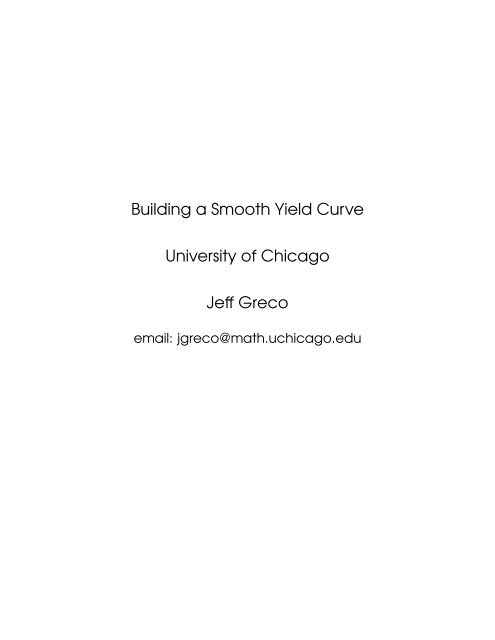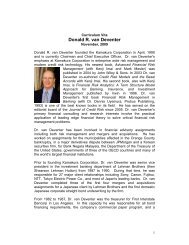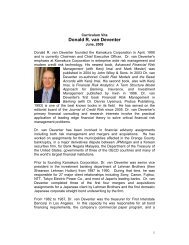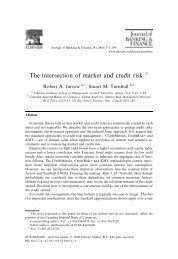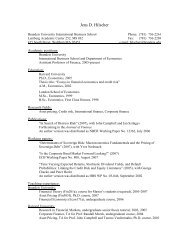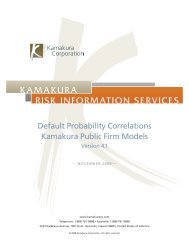the full text of Professor Greco's lecture notes on yield curve smoothing
the full text of Professor Greco's lecture notes on yield curve smoothing
the full text of Professor Greco's lecture notes on yield curve smoothing
Create successful ePaper yourself
Turn your PDF publications into a flip-book with our unique Google optimized e-Paper software.
Building a Smooth Yield Curve<br />
University <str<strong>on</strong>g>of</str<strong>on</strong>g> Chicago<br />
Jeff Greco<br />
email: jgreco@math.uchicago.edu
Preliminaries<br />
As before, we will use c<strong>on</strong>tinuously compounding<br />
Act/365 rates for both <str<strong>on</strong>g>the</str<strong>on</strong>g> zero coup<strong>on</strong> rates<br />
and forward rates. Time is measured in years from<br />
now. Recall <str<strong>on</strong>g>the</str<strong>on</strong>g> following quantities:<br />
Name Symbol Formulas<br />
discount<br />
e −r(t)·t<br />
P (t)<br />
factor<br />
e − ∫ t<br />
0 f(s)ds<br />
forward<br />
discount<br />
factor<br />
zero<br />
rate<br />
discrete<br />
forward<br />
rate<br />
instantaneous<br />
forward<br />
rate<br />
P (t, T )<br />
r (t)<br />
f (t, T )<br />
f (t)<br />
e−f(t,T )(T −t)<br />
P (T )<br />
P (t)<br />
− 1 t<br />
log P (t)<br />
1 ∫ t0<br />
t<br />
f (s) ds<br />
r(T )·T −r(t)·t<br />
T −t<br />
−T 1<br />
−t<br />
log P (t, T )<br />
−dt d log P (t)<br />
lim τ↓0 f (t, t + τ)<br />
d<br />
dt (r (t) · t) 1
Mechanics<br />
Let<br />
0 = t 0 < t 1 < · · · < t n<br />
be an ordered set <str<strong>on</strong>g>of</str<strong>on</strong>g> times. A <strong>yield</strong> <strong>curve</strong> is represented<br />
by any <str<strong>on</strong>g>of</str<strong>on</strong>g> <str<strong>on</strong>g>the</str<strong>on</strong>g> following:<br />
• Discount factors P (t 1 ) , P (t 2 ) , . . . , P (t n ),<br />
• Zero rates r (t 1 ) , r (t 2 ) , . . . , r (t n ), or<br />
• Forward rates f (t 0 , t 1 ) , f (t 1 , t 2 ) , . . . , f ( t n−1 , t n<br />
)<br />
.<br />
These are all equivalent, as can be seen by <str<strong>on</strong>g>the</str<strong>on</strong>g><br />
relati<strong>on</strong>s<br />
P (t i ) = e −r(t i)·t i ,<br />
r (t i ) · t i = r ( t i−1<br />
)<br />
· ti−1 + f ( t i−1 , t i<br />
) (<br />
ti − t i−1<br />
)<br />
.<br />
2
What is Smoothness?<br />
Smoothness is a measure <str<strong>on</strong>g>of</str<strong>on</strong>g> <str<strong>on</strong>g>the</str<strong>on</strong>g> degree to which<br />
a functi<strong>on</strong> wriggles. A smoothness penalty is <str<strong>on</strong>g>of</str<strong>on</strong>g>ten<br />
defined as<br />
∫ (f<br />
′′ (t)<br />
) 2<br />
dt<br />
or<br />
∫ ∣ ∣∣f ′ (t)<br />
∣ ∣∣ dt.<br />
The zero rates are averages <str<strong>on</strong>g>of</str<strong>on</strong>g> forward rates<br />
∫ t<br />
r (t) = 1 f (s) ds<br />
t 0<br />
and are <str<strong>on</strong>g>the</str<strong>on</strong>g>refore smoo<str<strong>on</strong>g>the</str<strong>on</strong>g>r. This implies that if<br />
we smooth <str<strong>on</strong>g>the</str<strong>on</strong>g> forward rates, <str<strong>on</strong>g>the</str<strong>on</strong>g> zero rates will<br />
also be smooth. So what will be <str<strong>on</strong>g>the</str<strong>on</strong>g> criteri<strong>on</strong> <str<strong>on</strong>g>of</str<strong>on</strong>g><br />
smoothness for our discrete sequence <str<strong>on</strong>g>of</str<strong>on</strong>g> forward<br />
rates?<br />
f 1 = f (t 0 , t 1 ) , f 2 = f (t 1 , t 2 ) , . . . , f n = f ( t n−1 , t n<br />
)<br />
3
We shall choose a discrete versi<strong>on</strong> <str<strong>on</strong>g>of</str<strong>on</strong>g> <strong>on</strong>e <str<strong>on</strong>g>of</str<strong>on</strong>g> <str<strong>on</strong>g>the</str<strong>on</strong>g><br />
c<strong>on</strong>tinuous time measures we have already seen.<br />
One possibility is that a forward rate should be<br />
“close” to its neighbors, e.g.<br />
n∑<br />
i=2<br />
|f i − f i−1 |<br />
should be small. The absolute value is tricky to<br />
deal with, so we will use <str<strong>on</strong>g>the</str<strong>on</strong>g> squares <str<strong>on</strong>g>of</str<strong>on</strong>g> <str<strong>on</strong>g>the</str<strong>on</strong>g> differences<br />
instead<br />
S(f) =<br />
Ano<str<strong>on</strong>g>the</str<strong>on</strong>g>r possibility is<br />
n∑<br />
i=2<br />
(<br />
fi − f i−1<br />
) 2 .<br />
n−1 ∑<br />
i=2<br />
(<br />
fi−1 − 2f i + f i+1<br />
) 2<br />
.
Why is Smoothing Possible?<br />
The prices <str<strong>on</strong>g>of</str<strong>on</strong>g> <str<strong>on</strong>g>the</str<strong>on</strong>g> traded input instruments (deposits,<br />
Eurodollar futures, and swaps) are functi<strong>on</strong>s<br />
<str<strong>on</strong>g>of</str<strong>on</strong>g> <str<strong>on</strong>g>the</str<strong>on</strong>g> forward rates. The forward rates are<br />
not uniquely determined by <str<strong>on</strong>g>the</str<strong>on</strong>g>se prices. There<br />
are always extra degrees <str<strong>on</strong>g>of</str<strong>on</strong>g> freedom. When we<br />
bootstrapped <str<strong>on</strong>g>the</str<strong>on</strong>g> LIBOR <strong>curve</strong> in <str<strong>on</strong>g>the</str<strong>on</strong>g> previous <str<strong>on</strong>g>lecture</str<strong>on</strong>g>,<br />
we chose a c<strong>on</strong>stant forward rate interpolati<strong>on</strong><br />
method in order to specify <str<strong>on</strong>g>the</str<strong>on</strong>g> <strong>curve</strong>.<br />
We used a total <str<strong>on</strong>g>of</str<strong>on</strong>g> 23 c<strong>on</strong>straints (instruments) to<br />
c<strong>on</strong>struct <str<strong>on</strong>g>the</str<strong>on</strong>g> <strong>curve</strong>. The number <str<strong>on</strong>g>of</str<strong>on</strong>g> unknowns<br />
(forward rates) is equal to <str<strong>on</strong>g>the</str<strong>on</strong>g> number <str<strong>on</strong>g>of</str<strong>on</strong>g> knot times.<br />
A knot time is a time whose corresp<strong>on</strong>ding discount<br />
factor impacts <str<strong>on</strong>g>the</str<strong>on</strong>g> value <str<strong>on</strong>g>of</str<strong>on</strong>g> any <str<strong>on</strong>g>of</str<strong>on</strong>g> <str<strong>on</strong>g>the</str<strong>on</strong>g> input<br />
instruments:<br />
4
• Deposit begin and end dates<br />
• Futures IMM dates and end dates<br />
• Swap fixed cashflow payment dates<br />
We have at least 41 knot times and <strong>on</strong>ly 23 c<strong>on</strong>straints.<br />
That leaves at least an extra 18 degrees<br />
<str<strong>on</strong>g>of</str<strong>on</strong>g> freedom! We will use <str<strong>on</strong>g>the</str<strong>on</strong>g>m for <strong>smoothing</strong>.<br />
5
The Dangers <str<strong>on</strong>g>of</str<strong>on</strong>g> Overfitting<br />
Underfitting is when <str<strong>on</strong>g>the</str<strong>on</strong>g> number <str<strong>on</strong>g>of</str<strong>on</strong>g> c<strong>on</strong>straints is<br />
greater than <str<strong>on</strong>g>the</str<strong>on</strong>g> number <str<strong>on</strong>g>of</str<strong>on</strong>g> free variables. This is<br />
relatively benign. Generally, not every c<strong>on</strong>straint<br />
can be satisfied. Fewer c<strong>on</strong>straints than free variables<br />
results in overfitting. Ad-hoc procedures for<br />
fixing extra variables usually result in unpleasant<br />
c<strong>on</strong>sequences. Extra variables go haywire. Overfitting<br />
is extremely widespread but usually hidden!<br />
Watch out for it in<br />
• Curve building<br />
• Model calibrati<strong>on</strong><br />
• Market (BGM) models<br />
• Everywhere else<br />
6
Overfitted models are unstable, have little explanatory<br />
and predictive power, yet provide a false sense<br />
<str<strong>on</strong>g>of</str<strong>on</strong>g> security (because all inputs are matched).<br />
Ways to deal with overfitting:<br />
• Recognize it<br />
• Avoid it<br />
• Formulate a goal that extra parameters are<br />
designed to achieve<br />
7
A Simple Example<br />
C<strong>on</strong>sider two instruments<br />
• A Eurodollar deposit<br />
• A Eurodollar future<br />
Assume that <str<strong>on</strong>g>the</str<strong>on</strong>g> deposit settles at time t 0 and<br />
pays at time t 2 . The Eurodollar covers <str<strong>on</strong>g>the</str<strong>on</strong>g> time<br />
period from t 1 to t 3 . The times are arranged in<br />
order t 0 < t 1 < t 2 < t 3 . Assume all day bases are<br />
Act/365. Define<br />
τ 1 = t 1 − t 0 ,<br />
τ 2 = t 2 − t 1 ,<br />
τ 3 = t 3 − t 1 .<br />
8
The three forwards involved are<br />
f 1 = f (t 0 , t 1 ) ,<br />
f 2 = f (t 1 , t 2 ) ,<br />
f 3 = f (t 2 , t 3 ) .<br />
Two equati<strong>on</strong>s must be satisfied by <str<strong>on</strong>g>the</str<strong>on</strong>g> forward<br />
rates,<br />
D = exp (f 1τ 1 + f 2 τ 2 ) − 1<br />
τ 1 + τ 2<br />
,<br />
F = exp (f 2τ 2 + f 3 τ 3 ) − 1<br />
τ 2 + τ 3<br />
,<br />
where D is <str<strong>on</strong>g>the</str<strong>on</strong>g> deposit rate and F is <str<strong>on</strong>g>the</str<strong>on</strong>g> rate implied<br />
by <str<strong>on</strong>g>the</str<strong>on</strong>g> futures price. Expressed in term <str<strong>on</strong>g>of</str<strong>on</strong>g><br />
forward rates, <str<strong>on</strong>g>the</str<strong>on</strong>g> c<strong>on</strong>straints become<br />
τ 1 f 1 + τ 2 f 2 = log (D (τ 1 + τ 2 ) + 1)<br />
τ 2 f 2 + τ 3 f 3 = log (F (τ 2 + τ 3 ) + 1) .<br />
We have two equati<strong>on</strong>s and three unknowns. We<br />
want <str<strong>on</strong>g>the</str<strong>on</strong>g> smoo<str<strong>on</strong>g>the</str<strong>on</strong>g>st <strong>curve</strong> possible. Recall our<br />
definiti<strong>on</strong> <str<strong>on</strong>g>of</str<strong>on</strong>g> smoothness. The goal is to minimize<br />
S (f 1 , f 2 , f 3 ) = (f 2 − f 1 ) 2 + (f 3 − f 2 ) 2
using <str<strong>on</strong>g>the</str<strong>on</strong>g> extra degree <str<strong>on</strong>g>of</str<strong>on</strong>g> freedom. By direct substituti<strong>on</strong><br />
f 1 = log (D (τ 1 + τ 2 ) + 1) − f 2 τ 2<br />
τ 1<br />
f 3 = log (F (τ 2 + τ 3 ) + 1) − f 2 τ 2<br />
τ 3<br />
.<br />
Plugging into S (f 1 , f 2 , f 3 ) leaves a <strong>on</strong>e dimensi<strong>on</strong>al<br />
unc<strong>on</strong>strained optimizati<strong>on</strong> problem. Find<br />
f 2 where <str<strong>on</strong>g>the</str<strong>on</strong>g> minimum <str<strong>on</strong>g>of</str<strong>on</strong>g><br />
S (f 2 ) =<br />
is attained.<br />
((<br />
+<br />
1 + τ 2<br />
((<br />
τ 1<br />
)<br />
f 2 − log (D (τ ) 2<br />
1 + τ 2 ) + 1)<br />
τ 1<br />
1 + τ )<br />
2<br />
f 2 − log (F (τ ) 2<br />
2 + τ 3 ) + 1)<br />
τ 3 τ 3<br />
Do this as an exercise!
The Method in Detail<br />
Step 1: Identify <str<strong>on</strong>g>the</str<strong>on</strong>g> instruments used in c<strong>on</strong>structing<br />
<str<strong>on</strong>g>the</str<strong>on</strong>g> <strong>curve</strong><br />
• Deposits / LIBOR rates<br />
• Eurodollar futures<br />
• Swaps<br />
We will call <str<strong>on</strong>g>the</str<strong>on</strong>g>m “<strong>curve</strong> instruments”.<br />
9
Step 2: Identify knot times<br />
The knot times are characterized as <str<strong>on</strong>g>the</str<strong>on</strong>g> set <str<strong>on</strong>g>of</str<strong>on</strong>g><br />
times whose corresp<strong>on</strong>ding discount factors impact<br />
<str<strong>on</strong>g>the</str<strong>on</strong>g> value <str<strong>on</strong>g>of</str<strong>on</strong>g> <str<strong>on</strong>g>the</str<strong>on</strong>g> <strong>curve</strong> instruments. Knot<br />
times include<br />
• Today<br />
• Deposit accrual begin dates and end dates<br />
• Eurodollar futures underlying forward LIBOR begin<br />
and end dates<br />
• Swap settlement dates and fixed rate payment<br />
dates<br />
Sort <str<strong>on</strong>g>the</str<strong>on</strong>g> knot times<br />
0 = t 0 < t 1 < · · · < t n ,<br />
breaking <str<strong>on</strong>g>the</str<strong>on</strong>g> timeline into n<strong>on</strong>-overlapping periods.<br />
10
Step 3: Assign a forward rate (free variable) to<br />
each time period<br />
f 1 = f (t 0 , t 1 ) , f 2 = f (t 1 , t 2 ) , . . . , f n = f ( t n−1 , t n<br />
)<br />
,<br />
establishing n independent variables.<br />
Step 4: Express <str<strong>on</strong>g>the</str<strong>on</strong>g> <strong>curve</strong> instrument prices as functi<strong>on</strong>s<br />
<str<strong>on</strong>g>of</str<strong>on</strong>g> <str<strong>on</strong>g>the</str<strong>on</strong>g> forward rates<br />
• First express <str<strong>on</strong>g>the</str<strong>on</strong>g> <strong>curve</strong> instrument prices through<br />
<str<strong>on</strong>g>the</str<strong>on</strong>g> discount factors at <str<strong>on</strong>g>the</str<strong>on</strong>g> knot times<br />
P (t 1 ) , P (t 2 ) , . . . P (t n ) .<br />
This is always possible by definiti<strong>on</strong> <str<strong>on</strong>g>of</str<strong>on</strong>g> <str<strong>on</strong>g>the</str<strong>on</strong>g> knot<br />
times.<br />
• Sec<strong>on</strong>d express <str<strong>on</strong>g>the</str<strong>on</strong>g> discount factors in terms<br />
<str<strong>on</strong>g>of</str<strong>on</strong>g> <str<strong>on</strong>g>the</str<strong>on</strong>g> forward rates. This can be d<strong>on</strong>e recursively<br />
P (t 0 ) = 1,<br />
P (t i ) = P ( t i−1<br />
)<br />
exp<br />
(<br />
−fi · (t<br />
i − t i−1<br />
))<br />
.<br />
11
Step 5: Define c<strong>on</strong>straints<br />
The smoo<str<strong>on</strong>g>the</str<strong>on</strong>g>d <strong>curve</strong> should imply <strong>curve</strong> instrument<br />
prices which are a close match for market<br />
quotes. In o<str<strong>on</strong>g>the</str<strong>on</strong>g>r words<br />
V i (f 1 , f 2 , . . . , f n ) = v i , i = 1, 2, . . . , m.<br />
Here V 1 (f) , V 2 (f) , . . . , V m (f) are <str<strong>on</strong>g>the</str<strong>on</strong>g> prices as<br />
a functi<strong>on</strong> <str<strong>on</strong>g>of</str<strong>on</strong>g> <str<strong>on</strong>g>the</str<strong>on</strong>g> forward rates, and v 1 , v 2 , . . . v m<br />
are <str<strong>on</strong>g>the</str<strong>on</strong>g> market quotes we need to match. If m =<br />
n we are d<strong>on</strong>e; <str<strong>on</strong>g>the</str<strong>on</strong>g>re are no extra degrees <str<strong>on</strong>g>of</str<strong>on</strong>g><br />
freedom to use for smoothness. If m > n we have<br />
too many c<strong>on</strong>straints; we cannot match all <str<strong>on</strong>g>the</str<strong>on</strong>g><br />
prices. If, as is <str<strong>on</strong>g>the</str<strong>on</strong>g> usual case, m < n we can use<br />
<str<strong>on</strong>g>the</str<strong>on</strong>g> extra degrees <str<strong>on</strong>g>of</str<strong>on</strong>g> freedom for <strong>smoothing</strong>.
Step 6: Formulate a smoothness criteria<br />
Use<br />
S (f) =<br />
S (f) =<br />
or something else.<br />
n∑<br />
i=2<br />
n−1 ∑<br />
i=2<br />
(<br />
fi − f i−1<br />
) 2 ,<br />
(<br />
fi−1 − 2f i + f i+1<br />
) 2<br />
,<br />
12
Step 7: Solve a n<strong>on</strong>-linear c<strong>on</strong>strained optimizati<strong>on</strong><br />
problem<br />
Ma<str<strong>on</strong>g>the</str<strong>on</strong>g>matically we must find f such that S (f) is<br />
a minimum am<strong>on</strong>g all possible soluti<strong>on</strong>s V (f) =<br />
v. This is a very hard problem. It is a multidimensi<strong>on</strong>al<br />
(50+) minimizati<strong>on</strong> with n<strong>on</strong>-linear c<strong>on</strong>straints.<br />
This pushes <str<strong>on</strong>g>the</str<strong>on</strong>g> limit <str<strong>on</strong>g>of</str<strong>on</strong>g> numerical techniques.<br />
An alternative is to get rid <str<strong>on</strong>g>of</str<strong>on</strong>g> <str<strong>on</strong>g>the</str<strong>on</strong>g> hard c<strong>on</strong>straints.<br />
Use s<str<strong>on</strong>g>of</str<strong>on</strong>g>t c<strong>on</strong>straints instead. Replace V (f) = v<br />
with <str<strong>on</strong>g>the</str<strong>on</strong>g> mispricing objective functi<strong>on</strong><br />
M (f) =<br />
n∑<br />
i=1<br />
(V i (f) − v i ) 2 .<br />
The closer <str<strong>on</strong>g>the</str<strong>on</strong>g> fit to market prices, <str<strong>on</strong>g>the</str<strong>on</strong>g> smaller <str<strong>on</strong>g>the</str<strong>on</strong>g><br />
mispricing M (f). The reformulated problem is to<br />
find f such that<br />
Ω (f; w) = wS (f) + M (f)<br />
13
attains its minimum. We have included a c<strong>on</strong>trol<br />
variable w to specify <str<strong>on</strong>g>the</str<strong>on</strong>g> relative importance <str<strong>on</strong>g>of</str<strong>on</strong>g><br />
smoothness versus mispricing. This is a much simpler<br />
unc<strong>on</strong>strained optimizati<strong>on</strong> problem. Even<br />
Excel can handle it! The <strong>curve</strong> will no l<strong>on</strong>ger exactly<br />
price <str<strong>on</strong>g>the</str<strong>on</strong>g> input instruments. This is not necessarily<br />
bad – <str<strong>on</strong>g>the</str<strong>on</strong>g>re is always a bid/ask spread.<br />
We can fall within <str<strong>on</strong>g>the</str<strong>on</strong>g> bid/ask spread by choosing<br />
<str<strong>on</strong>g>the</str<strong>on</strong>g> right value for w. Typical bid/ask spreads<br />
are<br />
• Deposits: 1 2 bp<br />
• Eurodollars: 1 4 -1 2 bp<br />
• Swaps: 1-2bp
Advanced: C<strong>on</strong>necting <str<strong>on</strong>g>the</str<strong>on</strong>g> Dots<br />
We know <str<strong>on</strong>g>the</str<strong>on</strong>g> discrete forward rates for <str<strong>on</strong>g>the</str<strong>on</strong>g> knot<br />
times. But, how do we value o<str<strong>on</strong>g>the</str<strong>on</strong>g>r instruments<br />
that do not necessarily “hit” <str<strong>on</strong>g>the</str<strong>on</strong>g> knot times? Interpolate.<br />
Assuming flat forward rates between <str<strong>on</strong>g>the</str<strong>on</strong>g> knot times<br />
is <str<strong>on</strong>g>the</str<strong>on</strong>g> easy way out. We have worked hard to<br />
make <str<strong>on</strong>g>the</str<strong>on</strong>g> <strong>curve</strong> “smooth”. Why not c<strong>on</strong>nect <str<strong>on</strong>g>the</str<strong>on</strong>g><br />
dots smoothly? There are several choices for interpolati<strong>on</strong><br />
• Polynomial<br />
• Polynomial spline<br />
• Exp<strong>on</strong>ential spline<br />
• O<str<strong>on</strong>g>the</str<strong>on</strong>g>r families <str<strong>on</strong>g>of</str<strong>on</strong>g> smooth functi<strong>on</strong>s<br />
14
How do we choose? Be c<strong>on</strong>sistent.<br />
For instance, if you chose<br />
S (f) =<br />
n−1 ∑<br />
i=2<br />
(<br />
fi−1 − 2f i + f i+1<br />
) 2<br />
as your smoothness c<strong>on</strong>straint, <str<strong>on</strong>g>the</str<strong>on</strong>g>n why not try to<br />
extend this by minimizing ∫ ( f ′′ (t) ) 2 dt? In o<str<strong>on</strong>g>the</str<strong>on</strong>g>r<br />
words, find a twice differentiable functi<strong>on</strong> f (·)<br />
such that<br />
∫ tn ( )<br />
f<br />
′′ 2<br />
(s) ds (1)<br />
0<br />
is a minimum am<strong>on</strong>g all possible soluti<strong>on</strong>s<br />
1<br />
t i − t i−1<br />
∫ ti<br />
t i−1<br />
f (s) ds = f i , i = 1, 2, . . . n. (2)<br />
15
In order to achieve this we will invoke <str<strong>on</strong>g>the</str<strong>on</strong>g> following<br />
<str<strong>on</strong>g>the</str<strong>on</strong>g>orem ∗ .<br />
Theorem. The term structure <str<strong>on</strong>g>of</str<strong>on</strong>g> instantaneous forward<br />
rates f (t) , 0 ≤ t ≤ T , that minimizes <str<strong>on</strong>g>the</str<strong>on</strong>g><br />
smoothness criteria (1) subject to <str<strong>on</strong>g>the</str<strong>on</strong>g> c<strong>on</strong>straints<br />
(2) is a forth-order polynomial spline with knot times<br />
{t i } n i=0 .<br />
The coefficients <str<strong>on</strong>g>of</str<strong>on</strong>g> <str<strong>on</strong>g>the</str<strong>on</strong>g> spline are determined by<br />
solving a linear system <str<strong>on</strong>g>of</str<strong>on</strong>g> equati<strong>on</strong>s.<br />
∗ D<strong>on</strong>ald R. van Deventer and Kenji Imai. Financial Risk Analytics:<br />
A Term Structure Model Approach for Banking, Insurance<br />
and Investment Management, McGraw-Hill, 1996.<br />
16
Final Words <str<strong>on</strong>g>of</str<strong>on</strong>g> Wisdom<br />
• It is not always appropriate to smooth <str<strong>on</strong>g>the</str<strong>on</strong>g> <strong>yield</strong><br />
<strong>curve</strong> ∗ .<br />
• If <str<strong>on</strong>g>the</str<strong>on</strong>g> market data used to c<strong>on</strong>struct <str<strong>on</strong>g>the</str<strong>on</strong>g> <strong>curve</strong><br />
is bad, no amount <str<strong>on</strong>g>of</str<strong>on</strong>g> <strong>smoothing</strong> will fix it.<br />
• If different <strong>curve</strong> instruments have incompatible<br />
prices (e.g. <strong>on</strong>-<str<strong>on</strong>g>the</str<strong>on</strong>g>-run and <str<strong>on</strong>g>of</str<strong>on</strong>g>f-<str<strong>on</strong>g>the</str<strong>on</strong>g>-run<br />
Treasuries), <strong>smoothing</strong> will make matters worse.<br />
• When building a <strong>curve</strong> that has a scarce set<br />
<str<strong>on</strong>g>of</str<strong>on</strong>g> <strong>curve</strong> instruments (e.g. Treasury <strong>curve</strong>), some<br />
extra inputs should usually be used to “get it<br />
right” † .<br />
∗ For instance, when calculating price sensitivities to bucketed<br />
discrete forward rates, <strong>yield</strong> <strong>curve</strong> shocks will bleed<br />
into o<str<strong>on</strong>g>the</str<strong>on</strong>g>r buckets.<br />
† E.g., Treasury <strong>curve</strong> shape between 10 and 30 years<br />
forced to match <str<strong>on</strong>g>the</str<strong>on</strong>g> shape <str<strong>on</strong>g>of</str<strong>on</strong>g> <str<strong>on</strong>g>the</str<strong>on</strong>g> LIBOR <strong>curve</strong>.<br />
17


